高中英语非谓语动词用法详解及练习 含答案详解
(英语)高三英语非谓语动词技巧和方法完整版及练习题及解析
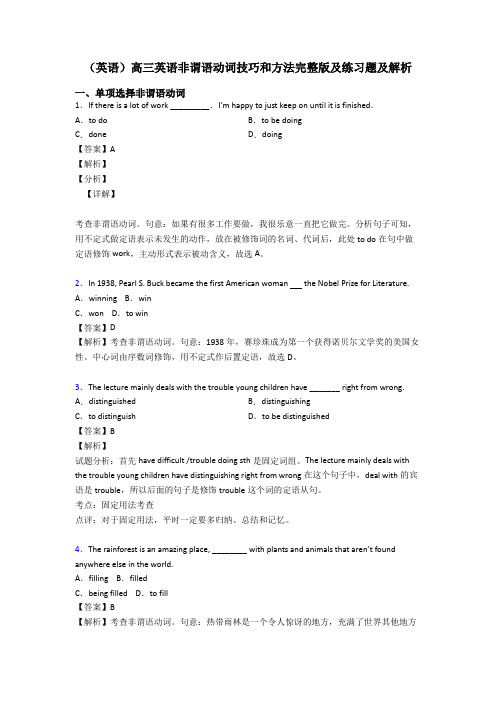
(英语)高三英语非谓语动词技巧和方法完整版及练习题及解析一、单项选择非谓语动词1.If there is a lot of work _________.I’m happy to just keep on until it is finished.A.to do B.to be doingC.done D.doing【答案】A【解析】【分析】【详解】考查非谓语动词。
句意:如果有很多工作要做,我很乐意一直把它做完。
分析句子可知,用不定式做定语表示未发生的动作,放在被修饰词的名词、代词后,此处to do在句中做定语修饰work,主动形式表示被动含义,故选A。
2.In 1938, Pearl S. Buck became the first American woman the Nobel Prize for Literature. A.winning B.winC.won D.to win【答案】D【解析】考查非谓语动词。
句意:1938年,赛珍珠成为第一个获得诺贝尔文学奖的美国女性。
中心词由序数词修饰,用不定式作后置定语,故选D。
3.The lecture mainly deals with the trouble young children have _______ right from wrong. A.distinguished B.distinguishingC.to distinguish D.to be distinguished【答案】B【解析】试题分析:首先have difficult /trouble doing sth是固定词组。
The lecture mainly deals with the trouble young children have distinguishing right from wrong在这个句子中,deal with的宾语是trouble,所以后面的句子是修饰trouble这个词的定语从句。
(英语)高三必备英语非谓语动词技巧全解及练习题(含答案)含解析

(英语)高三必备英语非谓语动词技巧全解及练习题(含答案)含解析一、单项选择非谓语动词1.He had wonderful childhood, _____with his mother to all corners of the world.A.travel B.to travel C.traveled D.traveling【答案】D【解析】【详解】考查非谓语动词。
句意:他有着美好的童年,跟母亲到过世界各地。
分析句子可知,travel 用非谓语动词形式,逻辑主语He与travel之间为主谓关系,因此用现在分词作状语。
故选D。
2.The recent financial crisis into account, the Japanese boss back on the number of employees working for him.A.taking; cuts B.was taken; cutC.taken; cut D.to take; cutting【答案】C【解析】【详解】考查过去分词和一般过去时。
句意:考虑到最近的金融危机,日本老板削减了为他工作的员工人数。
分析句子可知,本句为一般过去时,主语为故the Japanese boss ,谓语为cut。
The recent financial crisis 与take在逻辑上是被动关系,所以用过去分词。
C选项正确。
3.When he was a boy, he used to go there and watch _____.A.to repair bicycles B.bicycles to be repairedC.bicycles being repaired D.repairing bicycles【答案】C【解析】4.After a decade or so, out of choices, he returned to where he’d begun, ashamed at having so little to show for his wanderings.A.being run B.runningC.to run D.having run【答案】D【解析】【详解】考查现在分词。
高三英语非谓语动词解题技巧讲解及练习题(含答案)含解析
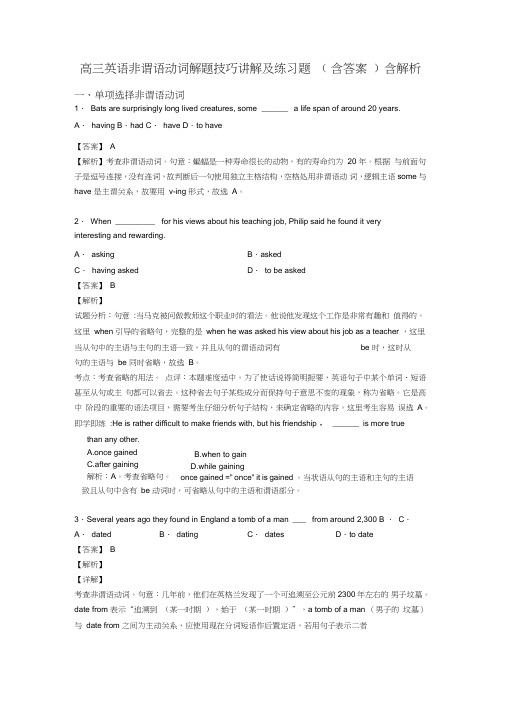
高三英语非谓语动词解题技巧讲解及练习题(含答案)含解析一、单项选择非谓语动词1.Bats are surprisingly long lived creatures, some ______ a life span of around 20 years. A.having B.had C.have D.to have【答案】A【解析】考查非谓语动词。
句意:蝙蝠是一种寿命很长的动物,有的寿命约为20 年。
根据与前面句子是逗号连接,没有连词,故判断后一句使用独立主格结构,空格处用非谓语动词,逻辑主语some 与have 是主谓关系,故要用v-ing 形式,故选A。
2.When _________ for his views about his teaching job, Philip said he found it veryinteresting and rewarding.A.asking B.askedC.having asked D.to be asked【答案】B【解析】试题分析:句意:当马克被问做教师这个职业时的看法。
他说他发现这个工作是非常有趣和值得的。
这里when 引导的省略句,完整的是when he was asked his view about his job as a teacher ,这里当从句中的主语与主句的主语一致,并且从句的谓语动词有be 时,这时从句的主语与be 同时省略,故选B。
考点:考查省略的用法。
点评:本题难度适中。
为了使话说得简明扼要,英语句子中某个单词、短语甚至从句或主句都可以省去。
这种省去句子某些成分而保持句子意思不变的现象,称为省略。
它是高中阶段的重要的语法项目,需要考生仔细分析句子结构,来确定省略的内容。
这里考生容易误选A。
即学即练:He is rather difficult to make friends with, but his friendship , ______ is more true than any other.A.once gainedC.after gaining解析:A。
高考必备英语非谓语动词技巧全解及练习题(含答案)
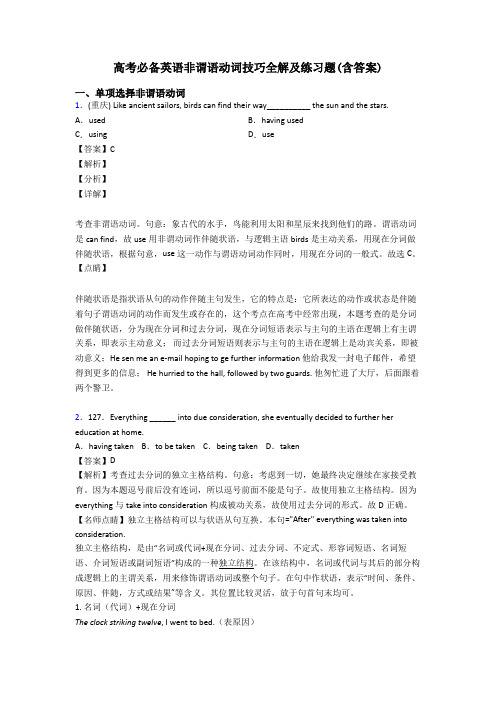
高考必备英语非谓语动词技巧全解及练习题(含答案)一、单项选择非谓语动词1.(重庆) Like ancient sailors, birds can find their way__________ the sun and the stars. A.used B.having usedC.using D.use【答案】C【解析】【分析】【详解】考查非谓语动词。
句意:象古代的水手,鸟能利用太阳和星辰来找到他们的路。
谓语动词是can find,故use用非谓动词作伴随状语,与逻辑主语birds是主动关系,用现在分词做伴随状语,根据句意,use这一动作与谓语动词动作同时,用现在分词的一般式。
故选C。
【点睛】伴随状语是指状语从句的动作伴随主句发生,它的特点是:它所表达的动作或状态是伴随着句子谓语动词的动作而发生或存在的,这个考点在高考中经常出现,本题考查的是分词做伴随状语,分为现在分词和过去分词,现在分词短语表示与主句的主语在逻辑上有主谓关系,即表示主动意义;而过去分词短语则表示与主句的主语在逻辑上是动宾关系,即被动意义;He sen me an e-mail hoping to ge further information 他给我发一封电子邮件,希望得到更多的信息; He hurried to the hall, followed by two guards. 他匆忙进了大厅,后面跟着两个警卫。
2.127.Everything ______ into due consideration, she eventually decided to further her education at home.A.having taken B.to be taken C.being taken D.taken【答案】D【解析】考查过去分词的独立主格结构。
句意:考虑到一切,她最终决定继续在家接受教育。
因为本题逗号前后没有连词,所以逗号前面不能是句子。
【英语】高二必备英语非谓语动词技巧全解及练习题(含答案)含解析

【英语】高二必备英语非谓语动词技巧全解及练习题(含答案)含解析一、单项选择非谓语动词1.The discovery of gold in Australia led thousands to believe that a fortune ______.A.is made B.would makeC.was to be made D.had made【答案】C【解析】试题分析:考查时态。
句义:在澳大利亚的黄金的发现让成千上万的人相信要发财了。
A. I made 一般过去时B. would make过去将来时C. was to be made 表过去将来且命中注定D. had made 过去完成时,根据句义是过去完成时,所以AD不对,根据题干黄金的发现所以注定要发财,所以C正确。
考点:考查时态。
2. herself with routine office work, she had no time to attend to her children. A.Occupying B.OccupiedC.Being occupied D.To be occupied【答案】A【解析】试题分析:A考察现在分词做状语:句意:每天忙于办公室的日常工作,她没时间照顾孩子。
Sb occupy oneself with sth某人忙于某事,这里的she和occupy是主动关系,用现在分词做状语,如果这题没有herself,就应该填occupied,用于词组be occupied with。
选A。
考点:考察非谓语动词。
3. Hours of playing violent video games can affect the way the brain works, ______ damage to certain cells of brain.A.to cause B.cause C.causing D.caused【答案】C【解析】试题分析:考查非谓语动词。
高考英语高中必备英语非谓语动词技巧全解及练习题(含答案)
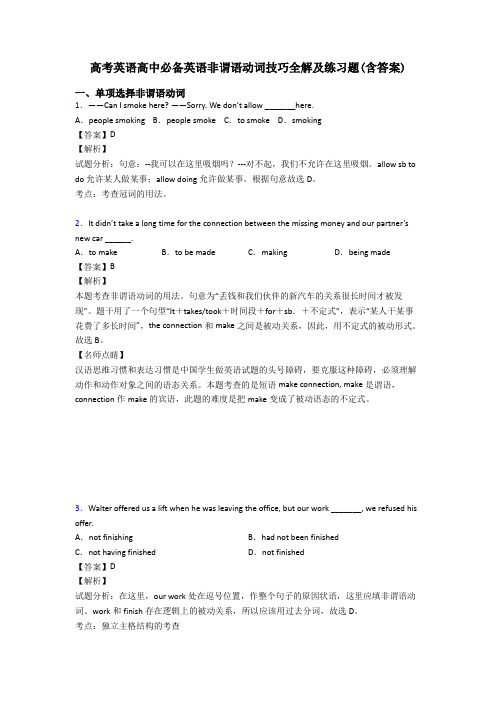
高考英语高中必备英语非谓语动词技巧全解及练习题(含答案)一、单项选择非谓语动词1.——Can I smoke here? ——Sorry. We don’t allow _______here.A.people smoking B.people smoke C.to smoke D.smoking【答案】D【解析】试题分析:句意:--我可以在这里吸烟吗?---对不起,我们不允许在这里吸烟。
allow sb to do 允许某人做某事;allow doing允许做某事。
根据句意故选D。
考点:考查冠词的用法。
2.It didn’t take a long time for the connection between the missing money and our partner’s new car ______.A.to make B.to be made C.making D.being made【答案】B【解析】本题考查非谓语动词的用法。
句意为“丢钱和我们伙伴的新汽车的关系很长时间才被发现”。
题干用了一个句型“It+takes/took+时间段+for+sb.+不定式”,表示“某人干某事花费了多长时间”,the connection和make之间是被动关系,因此,用不定式的被动形式。
故选B。
【名师点睛】汉语思维习惯和表达习惯是中国学生做英语试题的头号障碍,要克服这种障碍,必须理解动作和动作对象之间的语态关系。
本题考查的是短语make connection, make是谓语,connection作make的宾语,此题的难度是把make变成了被动语态的不定式。
3.Walter offered us a lift when he was leaving the office, but our work _______, we refused his offer.A.not finishing B.had not been finishedC.not having finished D.not finished【答案】D【解析】试题分析:在这里,our work处在逗号位置,作整个句子的原因状语,这里应填非谓语动词。
高考非谓语动词讲解及练习(含答案)

高考非谓语动词讲解及练习(含答案)一、单项选择非谓语动词1.On the third floor there are two rooms, ________ used as a meeting-room.A.the larger of which B.one of themC.and a larger of them D.the largest one of which【答案】B【解析】考查过去分词的独立主格结构。
句意:三楼有两个房间,其中一个被用作会议室。
如果选A项,是非限制性定语从句,从句应该用一般过去时态的被动语态,此处used是过去分词,所以A错;如果选C项,中间加and表明是并列句,the+比较级,才表示“两个当中更大的”,故C项错;因为是两个房间,不可能出现最高级,故D项错;只有选B项是过去分词的独立主格结构,符合题意。
【名师点睛】非谓语动词的独立主格结构一、独立主格结构的概念独立主格结构(Absolute Structure)是由名词或代词加上分词等构成的一种独立结构,用于修饰整个句子。
独立主格结构中的名词或代词与其后的分词等构成逻辑上的主谓关系。
这种结构与主句不发生句法上的联系,它的位置相当灵活,可置于主句前、主句末或主句中,常由逗号将其与主句分开。
需特别注意的是,独立主格结构与主句之间不能使用任何连接词。
二、独立主格结构基本构成形式名词(代词)+现在分词(过去分词;形容词;副词;不定式;名词;介词短语)1. 名词(代词)+现在分词There being no bus, we had to walk home.由于没有公共汽车,我们只好走回家。
2. 名词(代词)+过去分词The workers worked still harder, their living conditions greatly improved.由于工人们的生活条件大大提高,他们工作得更起劲了。
3. 名词(代词)+不定式在“名词/代词+动词不定式”结构中,动词不定式和它前面的名词或代词如果存在着逻辑上的主谓关系,动词不定式则用主动的形式;如果是动宾关系,则用被动形式。
非谓语动词作定语讲解及练习(附答案)

非谓语动词作定语一.不定式作定语1.不定式作定语常用于不定代词或被the first/next/only/last等修饰的名词和其他一些名词、代词之后。
其中,不定式的一般式通常表示的动作,完成式则表示该动作发生在谓语动词所表示的动作。
例如:She is always the first (one) to come and the last to leave.2.如果作定语的不定式与被修饰的名词有动宾关系,在不及物动词后通常要加上适当的介词。
例如:Let's first find a room to live in / to put the things in.We have nothing to worry about. (=There is nothing for us to worry about.)3.不定式作定语修饰一个在逻辑上是其宾语名词时,若在句子中能找到该不定式的逻辑主语, 则该不定式多用主动表被动,否则,用被动式。
(本结构是高考常考点)例如:I have a lot of things to do today. ( I ... do ... things)Have you got anything to say at the meeting? ( you... say ... anything)Here is a letter to be taken to Mr. Li.在there be句型中,有时用主动式或被动式意思不同。
1.2.our 1.分He is a student loved by all the teachers.The building being built will be the third Teaching Building of our school.2.像定语从句一样,分词作定语也有非限制性的,其作用相当于一个非限制性定语从句。
例如:The students, wearing their school uniforms, marched into the playground.The substance, discovered almost by accident,has greatly changed the world.非谓语动词做定语1.Many buildings in the city need repairing, but the one ______first is the library.A. repairedB. being repairedC. repairingD. to be repaired2.I'm calling to enquire about the position ________ in yesterday's China Daily.A. advertisedB. to be advertisedC. advertisingD. having advertised3.After she completes the project, she’ll have ________.A. nothing to worry aboutB. nothing to worryC. nothing to be worried aboutD. nothing worrying about4.His first book ______ next month is based on a true story.A. publishedB. to be publishedC. to publishD. being published5.The rare fish, _____ from the cooking pot, has been returned to the sea.A. savedB. savingC. to be savedD. having saved6. A great number of students ______ said they were forced to practise the piano.A. to questionB. to be questionedC. questionedD. questioning7.They built a house _____.A. of the things to put inB. of the things to be put inC. for the things to put inD. for the things to be put in8.That is the only way we can imagine __ the overuse of water in students'bathrooms.A. reducingB. to reduceC. reducedD. reduce9.There is a great deal of evidence ______that music activities engage different partsof the brain.A. indicateB. indicatingC. to indicateD. to be indicating10.We are invited to a party ______in our club next Friday.A. to be heldB. heldC. being heldD. holding11.The trees ________ in the storm have been moved off the road.A. being blown downB. blown downC. blowing downD. to blow down12.I have a lot of readings _____ before the end of this term.A. completingB. to completeC. completedD. being completed13.With the world changing fast, we have something new ______with all by ourselvesevery day.A. dealB. dealtC. to dealD. dealing14.The next thing he saw was smoke ______ from behind the house.A. roseB. risingC. to riseD. risen15.The government plans to bring in new laws _____ parents to take moreresponsibility for the education of their children.A. forcedB. forcingC. to be forcedD. having forced16.On receiving a phone call from his wife _____ she had a fall, Mr Gordonimmediately rushed home from office.A. saysB. saidC. sayingD. to say17.The players ____ from the whole country are expected to bring us honor in thissummer game .A. selectingB. to selectC. selectedD. having selected18.Simon made a big bamboo box _______ the little sick bird till it could fly.A. keepB. keptC. keepingD. to keep19.Peter received a letter just now ________ his grandma would come to see him soon.A.said B.says C.saying D.to say20.The island, ____ to the mainland by a bridge, is easy to go to.A. joiningB. to joinC. joinedD. having joined21.The rare fish, _____ from the cooking pot, has been returned to the sea.A. savedB. savingC. to be savedD. having saved22.Look over there—there’s a very long, winding path ______ up to the house.A. leadingB. leadsC. ledD. to lead23.Recently a survey _____ prices of the same goods in two different supermarketshas caused heated debate among citizens.A. comparedB. comparingC. comparesD. being compared24.The ability _____an idea is as important as the idea itself.A. expressingB. expressedC. to expressD. to be expressed25.Tsinghua University, ____ in 1911,is home to a great number of outstandingfigures.A. foundB. foundingC. foundedD. to be founded26.We’re having a meeting in half an hour. The decision ______at the meeting willinfluence the future of our company.A. to be madeB. being madeC. madeD. having been made27.After completing and signing it, please return the form to us in the envelope _____.A. providingB. providedC. having providedD. provide28.Time, ______ correctly, is money in the bank.A. to useB. usedC. usingD. use29.The lecture, _____ at 7:00 pm last night, was followed by an observation of themoon with telescopes.A. startingB. being startingC. to startD. to be started30.John has really got the job because he showed me the official letter _____ him it.A. offeredB. offeringC. to offerD. to be offered31.“It’s such a nice place,” Mother said as she s at at the table _____ for customers.A. to be reservedB. having reservedC. reservingD. reserved32. Now that we’ve discussed our problem, are people happy with the decisions __ ?A. takingB. takeC. taken D .to take33.The traffic rule says young children under the age of four and ____ less than 40 pounds must be in a child safety seat.A. being weighedB. to weighC. weighedD. weighing34. So far nobody has claimed the money ____ in the library.A. discoveredB. to be discoveredC. discoveringD. having discovered35. Mrs.White showed her students some old maps ______ from the library.A. to borrowB. to be borrowedC. borrowedD. borrowing答案1-5 DAABA 6-10 CDBBA 11-15 BBCBB 16-20 CCDCC21-25 AABCC 26-30 ABBAB 31-35 DCDAC。
高考非谓语动词讲解及练习(含答案)
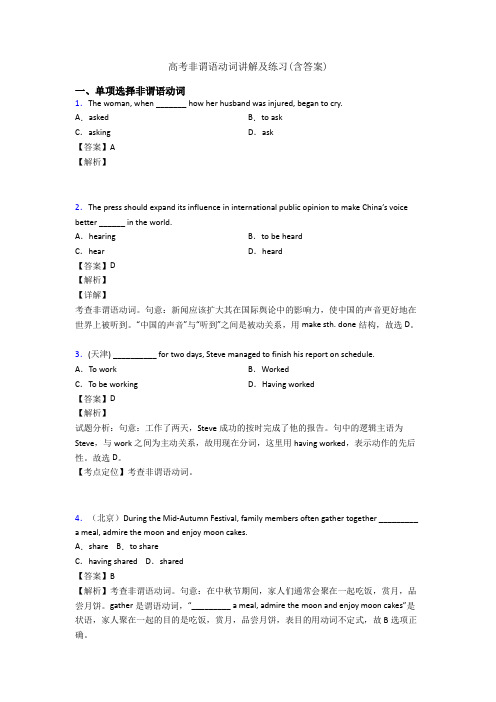
高考非谓语动词讲解及练习(含答案)一、单项选择非谓语动词1.The woman, when _______ how her husband was injured, began to cry.A.asked B.to askC.asking D.ask【答案】A【解析】2.The press should expand its influence in international public opinion to make China’s voice better ______ in the world.A.hearing B.to be heardC.hear D.heard【答案】D【解析】【详解】考查非谓语动词。
句意:新闻应该扩大其在国际舆论中的影响力,使中国的声音更好地在世界上被听到。
“中国的声音”与“听到”之间是被动关系,用make sth. done结构,故选D。
3.(天津) __________ for two days, Steve managed to finish his report on schedule.A.To work B.WorkedC.To be working D.Having worked【答案】D【解析】试题分析:句意:工作了两天,Steve成功的按时完成了他的报告。
句中的逻辑主语为Steve,与work之间为主动关系,故用现在分词,这里用having worked,表示动作的先后性。
故选D。
【考点定位】考查非谓语动词。
4.(北京)During the Mid-Autumn Festival, family members often gather together _________ a meal, admire the moon and enjoy moon cakes.A.share B.to shareC.having shared D.shared【答案】B【解析】考查非谓语动词。
高中非谓语动词练习题及答案详解

高中非谓语动词练习题及答案详解一、单项选择非谓语动词1.The Haiti earthquake at the beginning of 2010 is believed _______ more than 100,0130 people and makes millions homeless, ______ it perhaps the most destroying earthquake in history.A.to kill; making B.to have killed; making C.having killed; to make D.killing; made 【答案】B【解析】【详解】考查非谓语动词。
句意:据认为,2010年的海地地震造成了1000130人的死亡,几百万人无家可归,这使得它成为历史上最具破坏性的地震。
sth is believed to have done是固定句型,意思是“据认为……”,故第一空填to have killed;分析句式,第二空所在处做句子的结果状语,死伤人数众多,成为史上最严重的地震是自然而然的结果,用现在分词作结果状语,故选B。
2.________ terrible, the medicine was thrown away by the child.A.Tasted B.TastingC.To taste D.Being tasted【答案】B【解析】【详解】考查非谓语动词。
句意:这种药尝起来非常难吃,被这个孩子扔掉了。
主语是medicine,taste与主语是主动关系,而且taste是系动词无被动,因此用现在分词,故选B。
3.The discovery of gold in Australia led thousands to believe that a fortune ______.A.is made B.would makeC.was to be made D.had made【答案】C【解析】试题分析:考查时态。
高考英语非谓语动词试题(有答案和解析)含解析
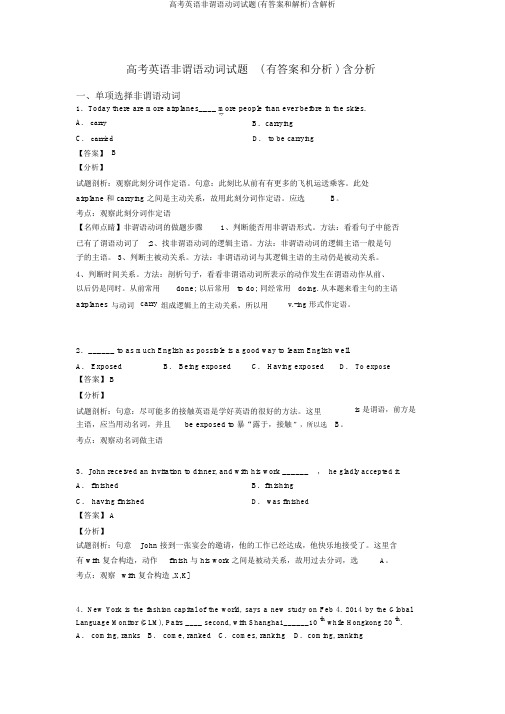
高考英语非谓语动词试题( 有答案和分析 ) 含分析一、单项选择非谓语动词1.Today there are more airplanes____ more people than ever before in the skies.A. carry B.carryingC. carried D. to be carrying【答案】B【分析】试题剖析:观察此刻分词作定语。
句意:此刻比从前有有更多的飞机运送乘客。
此处airplane 和 carrying 之间是主动关系,故用此刻分词作定语。
应选B。
考点:观察此刻分词作定语【名师点睛】非谓语动词的做题步骤1、判断能否用非谓语形式。
方法:看看句子中能否已有了谓语动词了;2、找非谓语动词的逻辑主语。
方法:非谓语动词的逻辑主语一般是句子的主语。
3、判断主被动关系。
方法:非谓语动词与其逻辑主语的主动仍是被动关系。
4、判断时间关系。
方法:剖析句子,看看非谓语动词所表示的动作发生在谓语动作从前、以后仍是同时。
从前常用done;以后常用to do;同经常用doing. 从本题来看主句的主语airplanes与动词carry组成逻辑上的主动关系,所以用v.-ing 形式作定语。
2.______ to as much English as possible is a good way to learn English well.A. Exposed B. Being exposed C. Having exposed D. To expose 【答案】 B【分析】试题剖析:句意:尽可能多的接触英语是学好英语的很好的方法。
这里主语,应当用动名词,并且be exposed to 暴“露于,接触”,所以选考点:观察动名词做主语B。
is 是谓语,前方是3.John received an invitation to dinner, and with his work ______,he gladly accepted it. A. finished B.finishingC. having finished D. was finished【答案】 A【分析】试题剖析:句意John 接到一张宴会的邀请,他的工作已经达成,他快乐地接受了。
高中英语非谓语动词用法详解及练习(含答案详解)
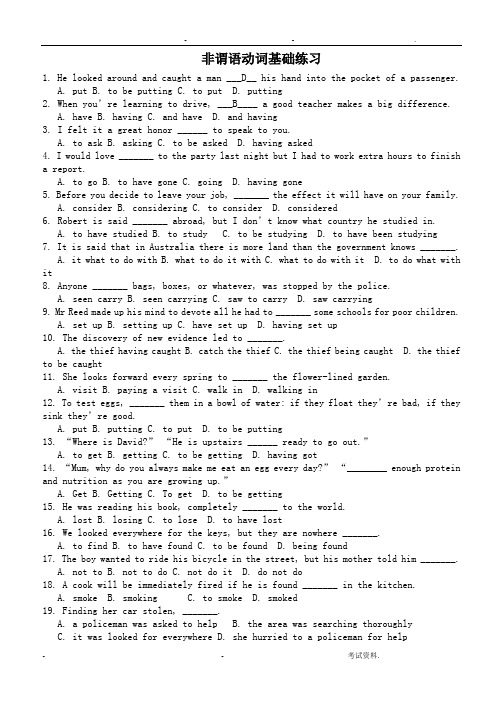
非谓语动词基础练习1. He looked around and caught a man ___D__ his hand into the pocket of a passenger.A. putB. to be puttingC. to putD. putting2. When you’re learning to drive, ___B____ a good teacher makes a big difference.A. haveB. havingC. and haveD. and having3. I felt it a great honor ______ to speak to you.A. to askB. askingC. to be askedD. having asked4. I would love _______ to the party last night but I had to work extra hours to finisha report.A. to goB. to have goneC. goingD. having gone5. Before you decide to leave your job, _______ the effect it will have on your family.A. considerB. consideringC. to considerD. considered6. Robert is said _______ abroad, but I don’t know what country he studied in.A. to have studiedB. to studyC. to be studyingD. to have been studying7. It is said that in Australia there is more land than the government knows _______.A. it what to do withB. what to do it withC. what to do with itD. to do what withit8. Anyone _______ bags, boxes, or whatever, was stopped by the police.A. seen carryB. seen carryingC. saw to carryD. saw carrying9. Mr Reed made up his mind to devote all he had to _______ some schools for poor children.A. set upB. setting upC. have set upD. having set up10. The discovery of new evidence led to _______.A. the thief having caughtB. catch the thiefC. the thief being caughtD. the thief to be caught11. She looks forward every spring to _______ the flower-lined garden.A. visitB. paying a visitC. walk inD. walking in12. To test eggs, _______ them in a bowl of water: if they float they’re bad, if they sink they’re good.A. putB. puttingC. to putD. to be putting13. “Where is David?” “He is upstairs ______ ready to go out.”A. to getB. gettingC. to be gettingD. having got14. “Mum, why do you always make me eat an egg every day?” “________ enough protein and nutrition as you are growing up.”A. GetB. GettingC. To getD. to be getting15. He was reading his book, completely _______ to the world.A. lostB. losingC. to loseD. to have lost16. We looked everywhere for the keys, but they are nowhere _______.A. to findB. to have foundC. to be foundD. being found17. The boy wanted to ride his bicycle in the street, but his mother told him _______.A. not toB. not to doC. not do itD. do not do18. A cook will be immediately fired if he is found _______ in the kitchen.A. smokeB. smokingC. to smokeD. smoked19. Finding her car stolen, _______.A. a policeman was asked to helpB. the area was searching thoroughlyC. it was looked for everywhereD. she hurried to a policeman for help20. “How do you deal with the disagreement between the company and the customers?” “The key ______ the problem is to meet the demand ______ by the customers.”A. to solving, makingB. to solving, madeC. to solve, makingD. to solve, made21. “What do you think made Mary so upset?” “_______ her new bike.”A. As she lostB. LostC. LosingD. Because of losing22. The research is so designed that once _______ nothing can be done to change it.A. beginsB. having begunC. beginningD. begun23. Though ________ money, his parents managed to send him to university.A. lackedB. lacking ofC. lackingD. lacked in24. Tony was very unhappy for _______ to the party.A. having not been invitedB. not having invitedC. having not invitedD. not having been invited25. Though I have often heard this song _______. I have never heard you _______ it.A. being sung, sangB. sang, singingC. sung, singD. to be sung, to sing非谓语动词提高练习1. The great hall was crowded with many people, __ many children __on their parents’ lapA. including; seatedB. including; seatingC. included; satD. included; sitting2. It’s said that the Olympic Games _____ in Beijing in 2008 w ill cover more events than any other Olympics did.A. holdingB. to be heldC. heldD. to be holding3. _____ for a long time, most of the crops in this area died from lacking water.A. Being no rainB. There was no rainC. To be no rainD. There being no rain4. Yesterday a street-beggar bought a lottery ticket purposelessly, _____ him a millionaire overnight.A. makingB. makesC. to makeD. made5. In the face of the big fire in October in California, many people in the fire-stricken areas moved out _____.A. to escape burningB. to escape being burnedC. escaping burnedD. escaping from burning6. Taking this medicine, if _____, will of course do good to his health.A. continuedB. to continueC. continuesD. continuing7. The little boy still needs the _____ 20 dollars to do with some things _____.A. remaining; remained to be settledB. remaining; remaining to be settledC. remained; remained to settleD. remained; remaining to settle8. _____ his age, the little boy read quite well.A. ConsideringB. ConsideredC. ConsiderD. Having considered9. _____ from the appearance, it is very peaceful; but in fact, a war will break out soon.A. JudgedB. JudgingC. Having judgedD. To judge10. —Tom enjoys _____ basketball on Sunday afternoons, doesn’t he? — Yes, he does. But what his sister enjoys _____.A. to play; dancingB. playing; to danceC. to play; to danceD. playing; is to dance11. His letter, _____ to the wrong number, reached me late.A. having been addressedB. to have addressedC. to have been addressedD. being addressed12. The Space Shuttle Columbia broke into pieces over Texas as it returned to the earthon February 1, 2003,_____ all seven astronauts aboard.A. having killedB. killingC. being killedD. killed13. There are lots of places of interest _____ in our city.A. needs repairingB. needing repairedC. needed repairingD. needing to be repaired14. — What caused the party to be put off? — _____ the invitations.A. Tom delayed sendingB. Tom’s delaying sendingC. Tom delaying to sendD. Tom delayed to send15. I was afraid _____ to my customers because I was afraid _____ them.A. of talking back; to loseB. of talking back; of losingC. to talk back; to loseD. to talk back; of losing16. Standing on the top of the hill, I would not do anything but _____ the flowing ofthe smog around me.A. enjoyB. enjoyingC. enjoyedD. to enjoy17. —Is Tom a good talker? —No, he never speaks to me other than _____ something?A. ask forB. to ask forC. asked forD. asking for18. I can’t get my car _____ on cold mornings, so I have to try _____ the radiator with some hot water.A. run; to fillB. running; fillingC. running; to fillD. ran; filling19. The drunken husband knocked against the table and sent the bowls _____ in all directions before he was sent _____ by his wife.A. flying; to sleepB. flying; sleepingC. to fly; to sleepingD. to fly; to sleep20. When we got back from the cinema, we found the lamp _____ but the door _____.A. being on; shutB. burning; shuttingC. burning; shutD. on; shutting21. We found the students seated at tables and had their eyes _____ on the scene of the launch of Shenzhou V spaceship.A. fixedB. fixC. fixingD. to fix22. A doctor can expect _____ at any hour of the day or night.A. callingB. to callC. being calledD. to be called23. The boy often gives a satisfactory answer to the teacher’s quest ion, _____ justa minute. So he’s usually the teacher’s pet.A. thoughtB. having thoughtC. and to thinkD. thinking24. The policeman came up to the lonely house with the door ____, ____ there for a whileand then entered it.A. open; to standB. opening; stoodC. open; stoodD. opened; standing25. _____ along the quiet road at forty miles an hour, and then an old man suddenly startedto cross the road in front of me.A. DrivingB. I was drivingC. Having drivenD. When I was driving26. Mr. Smith was much surprised to find the watch he had had _____ was nowhere to be seen.A. repairingB. it repairedC. repairedD. to be repaired27. What did the librarian _____ out of the library?A. permit to takeB. forbid to be takenC. allow to takeD. insist being taken28. — Mum, why do you give me so much popcorn? — _____ the boring time.A. KillB. KillingC. To killD. Having killed29. What Yang Liwei wanted to do when he got out of the spaceship was __ the joy withall the Chinese.A. shareB. sharedC. having sharedD. about to share30. When she was alone at home, Mary needed a friend _____.A. playing withB. having played withC. with whom to play withD. with whom to play31. _____ the big snake, the little girl stood under the tree _____ out of life.A. Seeing; frightenedB. Seeing; frighteningC. Seen; frightenedD. To see; frightening32. The competitor never dreamed of _____ for him to win the first prize in the 100-meter race.A. there was a chanceB. there being a chanceC. it being a chanceD. it was a chance33. _____ everything to go wrong in advance, and yo u won’t feel quite so bad when it does.A. Having expectedB. ExpectC. To expectD. Expecting34. —You _____ part in the party on time. —Sorry, I was delayed by the accident.A. are to takeB. have supposed to takeC. were to have takenD. supposed to take35. _____ with the size of the whole earth, the highest mountain doesn’t seem high atall.A. When comparedB. To compareC. While comparingD. It compared36. _____ in her best suit, the girl tried to make herself _____ at the party.A. Dressed; noticedB. Dressing; noticingC. Dressed; noticingD. Dressing; noticed37. The matter _____ your study surely requires _____ carefully.A. relating to; dealing withB. related to; dealt withC. related to; being dealt withD. relating to; having dealt with38. _____ made her parents worried a lot.A. Her not to come backB. Not her to come backC. Her not coming backD. Not her coming back39. Everything _____ into consideration, they believed themselves more and returned totheir positions.A. to takeB. takenC. to be takenD. taking40. He moved away from his parents and missed them _____ enjoy the exciting life in New York.A. much so as toB. very much toC. too much toD. enough to41. — What do you think of the plan? —It’s easier said than _____.A. carried outB. carrying outC. carry outD. to carry out42. Many businessmen attended the Boao Forum (博鳌论坛)because they knew what _____ fromthe forum.A. to getB. to be gotC. gotD. getting43. There was a famous person at the party whom everyone would like _____ to themselves.A. to introduceB. to be introducedC. introducingD. being introduced44. — Were you at home last Sunday? — Yeah! I devoted the whole day to _____ the English grammar.A. reviewB. reviewingC. be reviewedD. being reviewed45. Once _____ at the shop, you will be dismissed immediately.A. caught stealingB. caught to stealC. catching stealingD. to catch to steal46. Prices of daily goods _____ through a computer can be lower than store prices.A. are boughtB. boughtC. been boughtD. buying47. _____, John returned to school from his hometown.A. The summer vacation being overB. The summer vacation is overC. Becausethe summer vacation over D. After the summer vacation being over48. _____ she can’t come, who will do the work?A. SupposedB. SupposingC. Having supposedD. Being supposed49. — Is there anything you want from town? — No, thank you. But I would like toget _____.A. those letters mailedB. mailed lettersC. to mail those lettersD. those letters mail50. After the guests left, she spent as much time as she could _____ the rooms.A. tidy upB. to clear awayC. clear awayD. tidying up2012全国各地区高考非谓语动词汇总1【2012江西卷】33.Having finished her project, she was invited by the schoolto the new students.A.speaking B.having spoken C.to speak D.to have spoken2【2012江西卷】35.John has really got the job because he showed me the official letter ____________him it.A.offered B.offering C.to offer D.to be offered3【2012湖南卷】21. We've had a good start, but next, more work needs ____ to achieve the final success.A. being doneB. doC. to be doneD. to be4【2012重庆卷】31. Before you quit your job, ______how your family would feel about your decision.A. considerB. consideringC. to considerD. considered5【2012重庆卷】28. We’re having a meeting in half an hour. The decision ______ at the meeting will in the future ofour company.A. to be madeB. being madeC. madeD. having been made6【2012重庆卷】23.______to work overtime that evening, I missed a wonderful film.A. Having been askedB. To askC. Having askedD. To be asked7【2012辽宁卷】29. This machine is very easy . Anybody can learn to use it in a few minutes.A. operatingB. to be operatingC. operatedD. to operate8【2012四川卷】8. I looked up and noticed a snake ______ its way up the tree to catch its breakfast.A. to windB. windC. windingD. wound9【2012四川卷】12. Before driving into the city, you are required to get your car ____.A. washedB. washC. washingD. to wash10【2012陕西卷】15.________ in a long queue, we waited for the store to open to buy a New iPad .A. StandingB. To standC. StoodD. Stand11【2012陕西卷】22.If he takes on this work, he will have no choice but ______ an even greater challenge.A. meetsB. meetingC. meetD. to meet12【2012北京卷】23. One learns a language by making mistakes and ______ them.A.correctsB.correctC.to correctD.correcting13【2012北京卷】27. _______ with care, one tin will last for six weeks.A. UseB. UsingC. UsedD. To use14【2012全国II】15. The old man sat in front of the television every evening, happy _____ anything that happened to be on.A. to watchB. watchingC. watchedD. to have watched15【2012全国II】10. Tony lent me the money, ______that I’d do as much for him.A. hopingB. to hopeC. hopedD. having hoped16【2012北京卷】32. Birds’ singing is sometimes a warning to other birds ________ away.A. to stayB. stayingC. stayedD. stay17【2012天津卷】He got up late and hurried to his office, _________the breakfast untouched.A. leftB. to leaveC. leavingD. having left18【2012全国新课程】32. Film has a much shorter history, especially when_such art forms as music and painting.A. having compared toB. comparing toC. compare toD. compared to19【2012全国新课程】28. The party will be held in the garden, weather .A. permittingB. to permitC. permittedD. permit20【2012山东卷】35. After completing and signing it, please return the form to us in the envelope ________. A.providing B. provided C. having provided D. provide21【2012山东卷】26. George returned after the war, only _______ that his wife had left him. A. to be told B.telling C. being told D. told22【2012福建卷】28. China recently tightened its waters controls near the Huangyan Island to prevent Chinese fishing boats from in the South China Sea.A. attackingB. having attackedC. being attackedD. having been attacked23【2012福建卷】34. Pressed from his parents, and ______that he has wasted too much time , the boy is determined to stop playing video games.A. realizingB. realizedC. to realizeD. being realized24【2012浙江卷】1"It's a such nice place," Mother said as she sat at the table________ for customs.A. to be reservedB. Living reservedC. reservingD. reserved25【2012浙江卷】I think Tom, as the head of a big department, should either study regularly or________ _his job.A. quitsB. to quitC. quittingD. quit26【2012浙江卷】3. No matter how bright a talker you are, there are times when it's better__________silent.A. remainB. be remainingC. having remainedD. to remain27【2012江苏卷】31.__________an important decision more on emotion than on reason, you will regret it sooner or later.A. BasedB. BasingC. BaseD. To base28【2012安徽卷】30. When for his views about his teaching job, Philip said he found it very interesting and rewarding.A. askingB. askedC. having askedD. to be asked29【2012安徽卷】24. I remembered the door before I left the office, but forgot to turn off the lights.A. lockingB. to lockC. having lockedD. to have locked非谓语动词易错题型练习1 (1)I regret ____ you that your mother is absent in Beijing.⑵I don’t regret ____ her what I thought even if it might have upset her.A. to tellB. to tellingC. having toldD. tell2. ⑴We don’t allow _____ in the reading room.⑵We don’t allow them _____ in the reading room.A. to smokeB. smokingC. smokeD. smoked3.(1)___hard and you’ll make rapid progress in your English learning.⑵___hard, you’ll make rapid progress in your English learning.A. WorkingB. To workC. WorkD. Worked4. ⑴_____ , we went for a swim in the river.⑵_____, so we went for a swim in the river.A. Being hotB. It being hotC. As it hotD. It was hot5.⑴I can’t help ____ when I hear that terrible noise. A. laughing B. laughed C. laugh D. being laughed (2)I can’t help ____ the room, for I am very busy now. A. clean B. cleaning C. have clean D. cleaned6.⑴_____from the tower, Dalian looks more beautiful.⑵_____ from the tower, we can see our beautiful city .A. SeeingB. SeenC. To seeD. Having seen7. ⑴The sport meet ______ next week is of great importance.⑵The sports meet ______ now is very important⑶The sports meet ____ last week is of great importance.A. holdingB. being heldC. to be heldD. held8.⑴He raised his voice in order to make us ___ him.⑵He raised his voice in order to make himself _____.A. heardB. hearingC. hearD. to be heard9.(1)He stood there with his eyes _________ his mother.(2)He stood there, _______his mother.A. staring atB. stared onC. fixing uponD. fixed upon10.⑴Most of us went to see her, ____ some girls.⑵Most of us went to see her, some girls ____.A. includeB. includingC. includedD. to include11.⑴He was surprised to see some villagers ____ there.⑵To his surprise, he saw some villagers _____ themselves.A. seatB. seatedC. seatingD. to seat12.⑴The man _____ Zhaosan used to live here.⑵The man ____ himself Zhaosan used to lived here.A. calledB. callingC. to callD. call13.⑴He had no choice but ________ at the bus-stop in the rain.⑵He had nothing to do but ________ at the bus-stop in the rain.A. to waitB. waitingC. waitD. should wait.14.(1) I’m not free this evening because I have a lot of things ______.(2) He was so lazy that he had all of his washing ______.A. to doB. to be doneC. doingD. done15.(1)He often see them _______ football on the playground.⑵The missing boys were last seen _____ near the river.A. playingB. playedC. playD. to play16.(1) We are considering ___up a new factory here in this town.(2) We are considering how__ up a new factory here in this town.(3) The boy is considered ____a good example to his classmates.A. settingB. to setC. to have setD. having set17.(1) Mr Li is said ______ abroad? but I don’t know which country he studied in.(2) Mr Li is said ______ abroad? but I don’t know which country he is studying in.(3) Mr Li is said ______ abroad? but I don’t know which country he will s tudy in.A. to studyB. to have studiedC. to be studyingD. having studied18. (1)I insist that you ______ me my money back.(2)I insisted on your _____me my money back.A. giveB. to giveC. givingD. would give(3)The old man insisted that I ______ his wallet.A. has taken B. took C. should take D. had taken19. (1)I don't enjoy _____ fun of others.(2)I don't enjoy _____ fun of by others.A. to makeB. to be madeC. makingD. being made20.(1)If time _____, I'll go to see my friends tomorrow.(2)Time _____, I'll go to see my friends tomorrow.A. permittedB. permitsC. permittingD. permit21.(1)He had no choice but ____ aloud the text in the classroom..(2)He did nothing but _____ aloud the text in the classroom..A. readingB. to readC. readD. to be reading22. (1)_____ a good writer, he has a lot of things to learn.(2) ______ a good writer, he wrote a number of articles.A. To beB. BeingC. HavingD. Done23. (1) _____ his wallet ,he became very worried.(2)______in thought, he almost ran into the car in front of him.A. to loseB. losingC. lostD. having been lost24.(1) Having finished homework,______.(2) Having been finished, _______.A. the homework was handed inB. the teacher praised himC. he went home with his classmatesD. and he went home quickly25. Finding her car stolen, ____.A. a policeman was asked to helpB. the area was searched thoroughlyC. it was looked for everyoneD. She hurried to a policeman for help26. (1) The teacher came in,____ the Ss.(2) The teacher came in,____ by the Ss.A. followingB. followedC. having followedD. being followed27.(1)_____ more attention, the tree could have grown better.(2) _____ a hand to the poor, he felt very happy.A. giveB. givenC. to giveD. giving28.(1) Look around when ____ the street.(2) Look around before you ____ the streetA. crossB. crossingC. be crossingD. to be crossing29. (1)I would like to _____ the holiday with you, so I am sure I will come.(2)I would like to ____ the holiday with you, but I was really busy last week.A. spendB. spendingC. have spentD. having spent30. (1) The girl ____ in a colorful skirt looks beautiful.(2) The mother ___ her son must be late for the work.A. dressedB. dressingC. dressedD. dress◆答案与解析◆基础练习1. 选D。
高中英语非谓语动词解题技巧讲解及练习题(含答案)及解析

高中英语非谓语动词解题技巧讲解及练习题(含答案)及解析一、单项选择非谓语动词1.Mrs. Taylor went around the shops, ______ what she thought was necessary.A.ordered B.orderingC.to have ordered D.having been ordered【答案】B【解析】【详解】考查现在分词。
句意:泰勒太太逛了商店,订购了她认为必要的东西。
分析句子可知,Mrs. Taylor 与order在逻辑上是主动关系,所以用现在分词作状语。
故选B项。
2.Be careful when you deal with this chemical, as it will explode when ______ to sunlight. A.exposed B.to expose C.exposing D.being exposed【答案】A【解析】试题分析:考查非谓语动词。
本题考查短语be exposed to暴露与……。
句意:处理这种化学物质时要小心,因为它暴露在阳光下时会爆炸。
故A正确。
考点:考查非谓语动词3.Distinguished guests and friends, welcome to our school, _____the ceremony of the 50th Anniversary this morning are our alumni (校友) from home and abroad.A.Attend B.To attend C.Attending D.Having attended 【答案】C【解析】主句 .Distinguished guests and friends are our alumni (校友) from home and abroad. Attending the ceremony of the 50th Anniversary this morning非谓语动词作伴随状语。
非谓语动词讲解及练习(含答案)

非谓语动词解说及练习( 含答案 )一、单项选择非谓语动词1.New York is the fashion capital of the world, says a new study on Feb 4. 2014 by the Global Language Monitor (GLM), Pairs ____ second, with Shanghai ______10 th while Hongkong 20 th. A. coming, ranks B. come, ranked C.comes, ranking D.coming, ranking【答案】 D【分析】 D 考察非谓语动词。
句意: 2 月 4 日的一项新研究表示,纽约是世界的时髦之都。
2014 年全世界语言监测机构 (GLM)排名第二,上海排名第10,香港排名第20。
Come 和Pair 是主动关系用动词 ing 形式, rank 与 Shanghai 是主动关系,用动词 ing形式,应选 D。
2.China ’ s Chang ’ e 4 robotic probe entered lunar orbit on Wednesday, ________ a major step in its mission to make a soft landing on the moon’ s far side.A. marking C. having marked B.to mark D. marked【答案】 A【分析】【详解】考察非谓语动词。
句意:周三,中国的嫦娥 4 号机器人探测器进入月球轨道,标记着它在月球远端软着陆任务中迈出了重要一步。
逗号前是主句,逗号后是非限制性定语,修饰整个主句,联合句意,主句和mark之间是主动关系,故用此刻分词作定语, A 选项正确。
【点睛】不定式和此刻分词均可用结果状语,但二者用法有差别:此刻分词用作结果状语,往常表示一种自然的结果,即属料想之中的事;不定式用作结果状语,主要表示没有预想到的状况或结果,即属料想以外的事。
(英语)高一必备英语非谓语动词技巧全解及练习题(含答案)及解析

(英语)高一必备英语非谓语动词技巧全解及练习题(含答案)及解析一、单项选择非谓语动词1.The lecture, _______at 7:00 pm last night, was followed by an observation of the moon with telescopes.A.starting B.being startedC.to start D.to be started【答案】A【解析】选A start与逻辑主语the lecture之间为主动关系,故排除B、D两项。
不定式作定语时,常表示动作尚未发生,故排除C项,此处用现在分词作后置定语,表示主动。
第四步:根据与谓语动词的先后关系确定时态非谓语动词表示的动作发生在谓语动词表示的动作之前用过去分词或v.-ing形式/不定式的完成式;如果同时进行用v.-ing形式或不定式的进行式;如果非谓语动词表示的动作发生在谓语动词表示的动作之后用不定式的一般式。
2.Mrs. White showed her students some old maps ________ from the libraryA.to borrow B.borrowed C.to be borrowed D.borrowing【答案】B【解析】【详解】考查非谓语动词。
句意:怀特抬头给学生看一些从图书馆借来的旧地图。
分析句子可知,这里需要非谓语动词修饰maps,因为maps和borrow是被动关系吗,所以用过去分词做定语,故选B。
3.Be careful when you deal with this chemical, as it will explode when ______ to sunlight. A.exposed B.to expose C.exposing D.being exposed 【答案】A【解析】试题分析:考查非谓语动词。
本题考查短语be exposed to暴露与……。
高中必备英语非谓语动词技巧全解及练习题(含答案)含解析

高中必备英语非谓语动词技巧全解及练习题(含答案)含解析一、单项选择非谓语动词1.When we saw the road ________ with snow, we decided to spend the holiday at home. A.block B.to blockC.blocking D.blocked【答案】D【解析】【详解】考查非谓语动词。
句意:当我们看到路上被雪覆盖时,我们决定在家里度假。
此处用非谓语动词作宾补,动词block与see的宾语the road之间为被动关系,构成短语see sb/ sth done。
故选D。
2.Children who are over-protected by their parents may become _____.A.hurt B.spoiled C.damaged D.harmed【答案】B【解析】试题分析:考查动词辨析:句意:过分受父母保护的孩子可能会被惯坏。
spoil作为动词有“宠坏,溺爱”的意思,这里用动词的过去分词作形容词。
hurt指对身体或感情上的伤害;damaged指被毁坏或破坏(好像多指物);harmed指被损害,被伤害,被危害。
选B。
考点:考查动词辨析3.The players ________ from the whole country are expected to bring us honor in this summer game.A.selecting B.to selectC.selected D.having selected【答案】C【解析】【详解】考查非谓语动词。
句意:从全国各地挑选出来的运动员将在这场夏季比赛中为我们争光。
分析句子可知,select与players在逻辑上是被动关系,所以用过去分词。
故选C项。
4. the course very difficult, she decided to move to a lower level.A.Find B.FindingC.To find D.Found【答案】B【解析】【详解】考查非谓语动词。
- 1、下载文档前请自行甄别文档内容的完整性,平台不提供额外的编辑、内容补充、找答案等附加服务。
- 2、"仅部分预览"的文档,不可在线预览部分如存在完整性等问题,可反馈申请退款(可完整预览的文档不适用该条件!)。
- 3、如文档侵犯您的权益,请联系客服反馈,我们会尽快为您处理(人工客服工作时间:9:00-18:30)。
非谓语动词非谓语动词(一)——动词不定式动词不定式、分词(现在分词,过去分词)和动名词统称为非谓语动词。
现代英语将现在分词和动名词合为一大类叫作v + ing形式。
这些动词的形式不能在句中单独作谓语用,因而没有语法主语。
但可以有逻辑主语。
由于没有语法主语,也就不受人称和数的限定,因为不是谓语,也就没有时态和语态,但这些词仍能表示动作和状态,所以仍有表示与其他动词相对时间关系的形式。
由于与其它词有逻辑上的主谓关系,因此也有表示主、被动的形式,同时也有自己的宾语和状语,一起构成非谓语动词的短语(动词不定式短语,分词短语,动名词短语)。
动词不定式、过去分词及v-ing形式在句中均不能作谓语用,所以叫做非谓语动词。
(一)动词不定式:动词不定式由“to+ 动词原形”构成,如:to study, to play,动词不定式虽然不能作谓语动词用,但仍留着动词的特征,它可以带有所需要的宾语或状语而构成动词不定式短语,如:to study hard, to play table tennis。
语、宾语补足语、定语和状语用,如:(1)作主语:To help each other is good.(动词不定式作主语时,一般可用it作形式主语,而将作主语的动词不定式置于句末,如:It is good to help each other.(2)作表语:My job is to drive them to the power station every day. 动词不定式在系动词be之后作表语,与表示将来时的be + 动词不定式结构有所区别,如:Our plan is to set up another middle school for the peasants’ children.我们的计划是给农民子弟再成立一所中学。
(句中的谓语动词为is,动词不定式to set up… 为表语,主语为plan,但plan并不是动词不定式的逻辑主语,即动词不定式to set up 所表示的动作不是主语plan产生的。
)We are to set up another middl e school for the peasants’ children.我们将为农民的子弟再成立一所中学。
(句中的are to set up整个结构为句中谓语,主语为we,同时也是动词不定式to set up所表示的动作的逻辑主语,即动词不定式to set up所表示的动作是由we产生的)。
(3)作宾语:①作及物动词的宾语,如:She wishes to be a musician.;②作某些形容词的宾语:可以有动词不定式为宾语的形容词一般有glad, sorry, afraid, pleased, determined, willing, eager, anxious, ready, sure等,如:I am determined to give up smoking.;③动词不定式一般不作介词的宾语,但动词不定式之前如有疑问词时,就可作介词的宾语,如:Can you give us some advice on what to do next (4)作宾语补足语,如:Tell the children not to play on the street. 如果句中的谓语动词为see, hear, watch, notice, have, make, let等,作宾语补足语的动词不定式须将to省去,如:I saw a little girl run across the street.(5)动词不定式在句中作宾语,如带有宾语补足语时,须先用it作形式宾语,而将该动词不定式后置,如:I don’t think it right to do it that way.(6)作定语:动词不定式作定语时,须位于被其修饰的名词或代词之后,如:Is this the best way to help him 和定语用的动词不定式如果是不及物动词,不定式后面就要用必要的介词,如:He is the man to depend on. 如果被不定式修饰的名词为place, time, way,不定式后面的介词,习惯上可以省去,如:The old man is looking for a quiet place to live.(7)作状语:动词不定式可以作下列的状语:①目的状语:Every morning he gets up very early to read English. 为了强调不定式表示目的的作用,可在不定式前加in order to或so as to(以便或为了),但应注意in order to位于句首或句中均可,而so as to不能位于句首,如:She reads China Daily every day in order to (so as to) improve her English. 将表示目的的不定式置于句首,也可强调目的的作用,如:To master a foreign language, one must work hard at it. ②结果状语:They lived to see the liberation of their home town.他们活到亲眼见到了他们家乡的解放。
③too + 形容词或副词+ 动词不定式,表示“足能”的结果,如:You are old enough to take care of yourself now.3、复合结构不定式:由for + 名词(或代词宾格)+ 动词不定式即构成复合结构的动词不定式。
其中for本身无意义。
for后面的名词或代词是不定式的逻辑主语,这种不定式在句中可作主语、表语、宾语、定语或状语,如:It is very important for us to get everything ready for the harvest. 当作表语用的形容词表示不定式的逻辑主语的性质或特征时,就用介词of而不用for引出不定式的逻辑主语,这些形容词一般有good, nice, kind, wise, silly, stupid, foolish, right, wrong, careless, impolite等,如:It is very kind of you to help him every day.4、疑问词+ 动词不定式:疑问代词和疑问副词后可加动词不定式构成不定式短语,在句中可作主语、表语或宾语,如:How to prevent them from swimming in this river is a problem.5、动词不定式的否定式:动词不定式的否定式是由not + 动词不定式构成,如:It’s wrong of you not to attend the meeting.6、动词不定式的时态形式所表示的时间关系:(1)一般式:动词不定式一般式所表示的动作是和谓语动词所表示的动作同时发生,但在多数情况下,是在谓语动词所表示的动作之后发生,如:We decided to plant more trees this spring.(其后),They often watch us play table tennis.(同时);(2)完成式:动词不定式完成式所表示的动作发生在谓语动词所表示的动作之前,如:I am sorry to have kept you waiting.(3)进行式:动词不定式进行式所表示的动作正在进行中,而且与谓语动词所表示的动作同时发生,如:She happened to be writing a letter in the room when I came in.7、动词不定式的被动语态用法:如果动词不定式的逻辑主语为这个不定式所表示的动作的承受者时,不定式一般就用被动语态形式,如:What is to be done next hasn’t been decided yet.非谓语动词(二)——动词-ing形式(二)-ing形式:动词的-ing形式也是一种非谓语动词。
-ing形式仍保留有动词的特征,可以带有其所需要的宾语或状语而构成-ing短语。
1、-ing的形式:-ing有一般式和完成式。
及物动词的-ing还有主动语态和被动语态,而不及物动词的-ing则没有被动语态。
现在以及物动词make 和不及物动词go为例,将其-ing各种形式列表如下:2、-ing形式的基本用法。
(1)作主语:Seeing is believing.百闻不如一见。
Talking is easier than doing. –ing作主语时,如果其结构较长,可用it作形式主语,而将作主语的-ing后置。
如:It isn’t much good writing to them again. It’s no use waiting here.(2)作表语:Her job is washing and cooking. My hobby is collecting stamps.(3)作宾语:①作及物动词的宾语。
She likes drawing very much.;②作某些短语动词的宾语。
Mary is thinking of going back to New York.;③ do+限定词(my, some, any, the等)+ -ing,表示“做事”之意,如:We often do our cleaning on Saturday afternoon. Will you do any shopping on Saturday this afternoon ④作介词的宾语:Her sister is good at learning physics.;⑤作形容词worth, busy等的宾语:This book is well worth reading. –ing作宾语带有宾语补足语时,要用it作为形式宾语,而将作宾语的-ing后置,如:We found it no good talking like that. Do you think it necessary trying again(4)作定语:The sleeping child is only five years old. Do you know the man standing at the gate 注:-ing形式作定语用时,如果-ing只是一个单词,就位于其修饰的名词之前,如果是-ing短语,就位于其修饰的名词之后,-ing作定语时,被-ing所修饰的名词就是该-ing的逻辑主语。
